The Puppet Maker Redesigning Portland’s Keller Auditorium

Michael Curry, internationally renowned for his fantastical theater design, is the mind behind the Keller Auditorium and Fountain’s next era. Can the puppet maker’s imaginative approach to placemaking help reinvigorate downtown Portland?
Michael Curry leaned forward, knees bent and chin tucked to his chest. “At this point,” the celebrated artist and designer told me, while hugging his left arm across his ribs and extending his right high above his head, “I’m finding the method.” He swaggered and jittered, trampling around a corner of his workshop, and I understood he was a raptor. Holding his adopted frame, Curry grumbled a low growl and slithered his new long neck with searching tension. While it could surely get a laugh, the routine wasn’t a gag. He transformed. He believed he was a dinosaur. So did I.
It was early November, and I’d passed a winged chariot entering one of three corrugated metal buildings—airplane hangars, big ones—that make up Curry’s workshop in Scappoose, Oregon. Though he calls himself a puppet maker (and has the bruised fingernails to prove it), he’s also one of the world’s most in-demand theatrical designers. Famously, he codesigned the revolutionary puppetry for The Lion King on Broadway with the director Julie Taymor in the mid-’90s. But he’s since worked on Super Bowl halftime shows, Olympic ceremonies, even Taylor Swift’s stages. Other work thoroughly stretches the bounds of stagecraft, like the 32-foot-wide frog that sings Sinatra numbers above a faux waterfall he built at the Lake of Dreams in Las Vegas. Lately, he’s pushing things further. I’d come to Scappoose that day to figure out how a puppet maker wound up designing plans to remodel Portland’s lone Broadway theater, the Keller Auditorium.

Puppets from Curry’s workshop, including ones from The Lion King, Katy Perry’s Super Bowl show, and a Jurassic Park velociraptor.
In 2020, a seismic study found the Keller woefully behind code, leading the City of Portland to launch a design competition. Several proposals pitched building an alternative venue elsewhere in town: Start fresh and avoid canceling seasons during renovations. The host of touring Broadway productions and longtime home of Oregon Ballet Theatre’s annual Nutcracker juggernaut, it’s the kingpin of the local performing arts economy. But the building’s fate affects more than the theatergoing crowd. Remodeling would be a $300 million investment toward revitalizing downtown, an area deeply impacted by the houselessness and substance abuse crises. What the city decides to do with the 100-year-old auditorium says much about its plans, or hopes, for what was once its cultural core. As does deciding who designs the thing.
Curry grew up in a 200-person Baptist community in Grants Pass. While quite familiar with the Bible (“biggest drama in the world”), he had virtually no exposure to pop culture until he moved to Portland to attend the Museum Art School, since renamed Pacific Northwest College of Art. Everyone he met shared a common vernacular. They would say, “You know in Bewitched?” he recalled. “Rather than say, ‘No, I don’t know Bewitched,’ I would just like, clock it and then go watch Bewitched.”
Catching up didn’t necessarily help Curry blend in. While living in New York, he wore a homemade pterodactyl costume to the 1988 Greenwich Village Halloween Parade so impressively elaborate that theater director John Napier offered him a job on the street. Though he was pursuing painting and sculpture at the time, Curry worked on Siegfried & Roy’s show at Radio City Music Hall with Napier, then followed the production to the Mirage in Vegas. Suddenly, he was a theater designer. Despite moving back to Oregon in 1993, the work never let up: He signed a $1 million contract to build puppets for a theme park parade celebrating a new Disney flick called The Lion King that year. Taymor, with whom Curry had worked on a few plays in New York, signed on to direct the stage musical version a few years later. Did he want to help with the puppets?
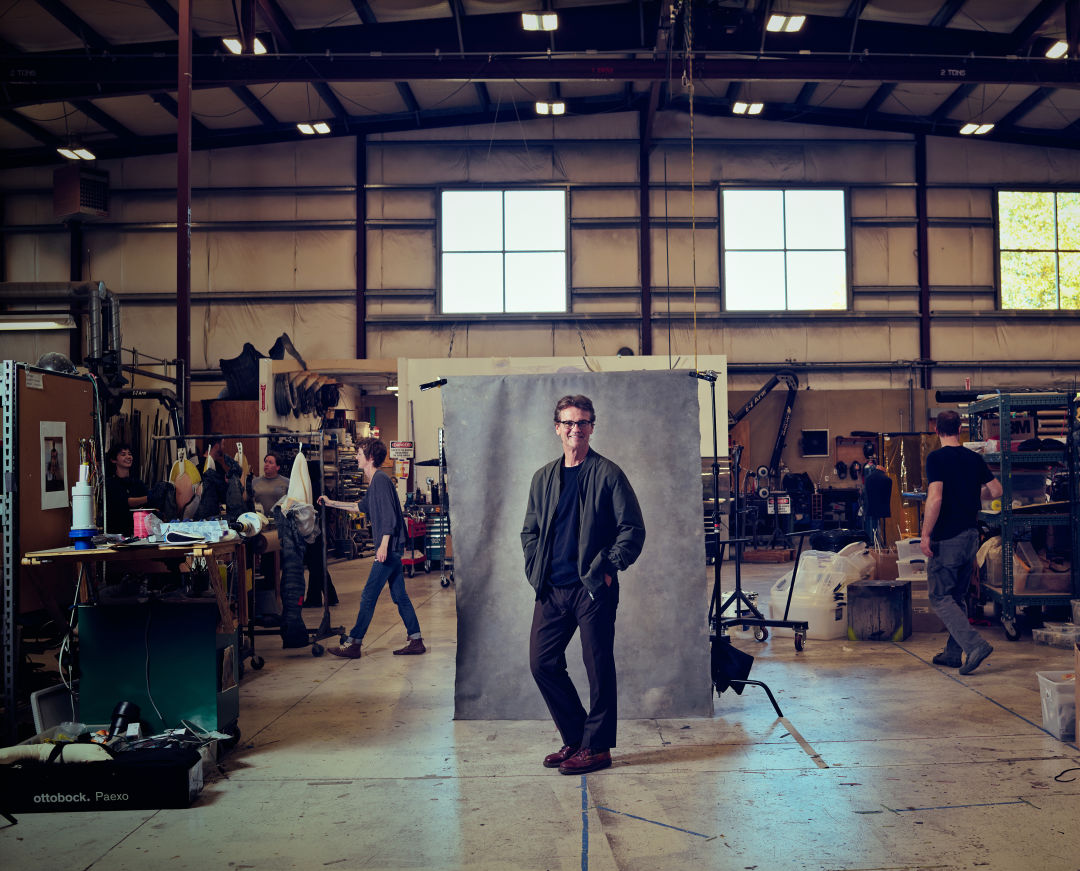
Curry in his sprawling workshop in Scappoose, 20 miles northwest of Portland.
Leading me around his “shop floor,” Curry, who will turn 67 in March, wore an army-green bomber jacket and Pendleton-print Docs. Drills and air compressors buzzed loudly. A dozen or so workers painting masks and assembling costumes revealed themselves as my eyes adjusted to the epic sprawl of industrial mills and lathes. Dinosaur appendages littered several workstations. A dozen claws on one rack, a split torso in the rafters. Giving some context to his performance, Curry explained they too were raptors, “structural costumes” for a Jurassic Park parade at Universal Studios. He posed with his head in one dinosaur’s mouth, using a lever to make it chomp him.
This wasn’t Geppetto’s hovel, nor the humble garage Curry seemed to view it as. As we went on, the puppets grew more involved, and his team’s designs began to fit all kinds of applications outside the world of performance. In the middle of the shop, an artisan was making 14-foot-long, carbon fiber drones in the shape of How to Train Your Dragon dragons, to fly over Universal Studios. They are “military spec,” Curry assured, as are the flying dementors from Harry Potter, which are active at a Japanese theme park right now. “Completely untethered,” Curry bragged. “And, yeah, they’re 22 feet long—scare the shit out of you.”
We walked into an office and he handed me a small gilt lion figurine—a maquette he’d used to pitch Katy Perry for her Super Bowl halftime show. On a computer, a designer was fine-tuning a robot-assisted suit for an upcoming project. They’d swapped notes with a military contractor, comparing each other’s real-life Iron Man suits. “We, out in Scappoose, being puppet makers, had a ton of advice for them,” Curry laughed. “We were a little surprised by some of the funkiness of their thing, really.”

In 1970, the Keller Fountain—then known as the Forecourt Fountain—wowed critics as a marvel of socioaesthetic design.
The Keller Auditorium hasn’t changed since its last renovation in 1970. Reporting from the ribbon cutting, New York Times architecture critic Ada Louise Huxtable spent her column gushing over the newly constructed Forecourt Fountain out front (later renamed the Keller Fountain). The “building of unrelieved blandness,” she wrote, “now becomes background for the forecourt—a fortuitous state of affairs.” The fountain mimics the Columbia River Gorge, with a series of stage-like platforms and Cubist plinths making a waterfall. A video of opening day shows crowds splashing in the water features. Hundreds of people hang off ledges and fill the surrounding park. Even with the nostalgic soft focus, there is an energy in the air. Huxtable compared it to Renaissance piazzas and articulated the energy it conjured as an exemplar of socioaesthetic design: “public city spaces of deliberately conceived beauty and pleasurable utility.” It took a single year to construct and cost roughly $500,000, or about $4 million in 2025 dollars.
Socioaesthetic design, called placemaking today, often relies on a handful of disparate specialists. The hope is to charge public space, to make a park that feels safe and is always full of people, a cohesive university campus, a plaza you can intuitively navigate. When successful, you want to use these spaces—to hang out, swim, dance, organize, fall in love. Lawrence Halprin, the landscape architect who designed the Keller Fountain, could be called a godfather of placemaking. The fountain, joined by a network of water features and public plazas he designed throughout the neighborhood, is a criterion of placemaking. In textbooks at least. In person, the sequence has grown lethargic.
Curry first got involved with the Keller renovations while working on a hometown run of The Lion King at the auditorium in 2016. The Halprin Landscape Conservancy, a nonprofit that maintains Halprin’s works in Portland, was holding an “ideas” competition to drum up interest in renovating the century-old theater. This competition preceded the city’s formal call for proposals, and there was no actionable funding attached, but the conservancy’s board includes such heavy hitters as the developer Bob Naito, son of Naito Parkway namesake Bill Naito.
The architect Don Stastny, known for judging design competitions like the one that manifested Pioneer Courthouse Square in the early ’80s, was overseeing the competition. He told me he tapped Curry for his artistry: “We thought, if he’s doing something on the inside, he might have some ideas about what happens outside as well.” Stastny needed someone who could sell a vision, Huxtable’s “deliberately conceived beauty.” Technical details could come later.
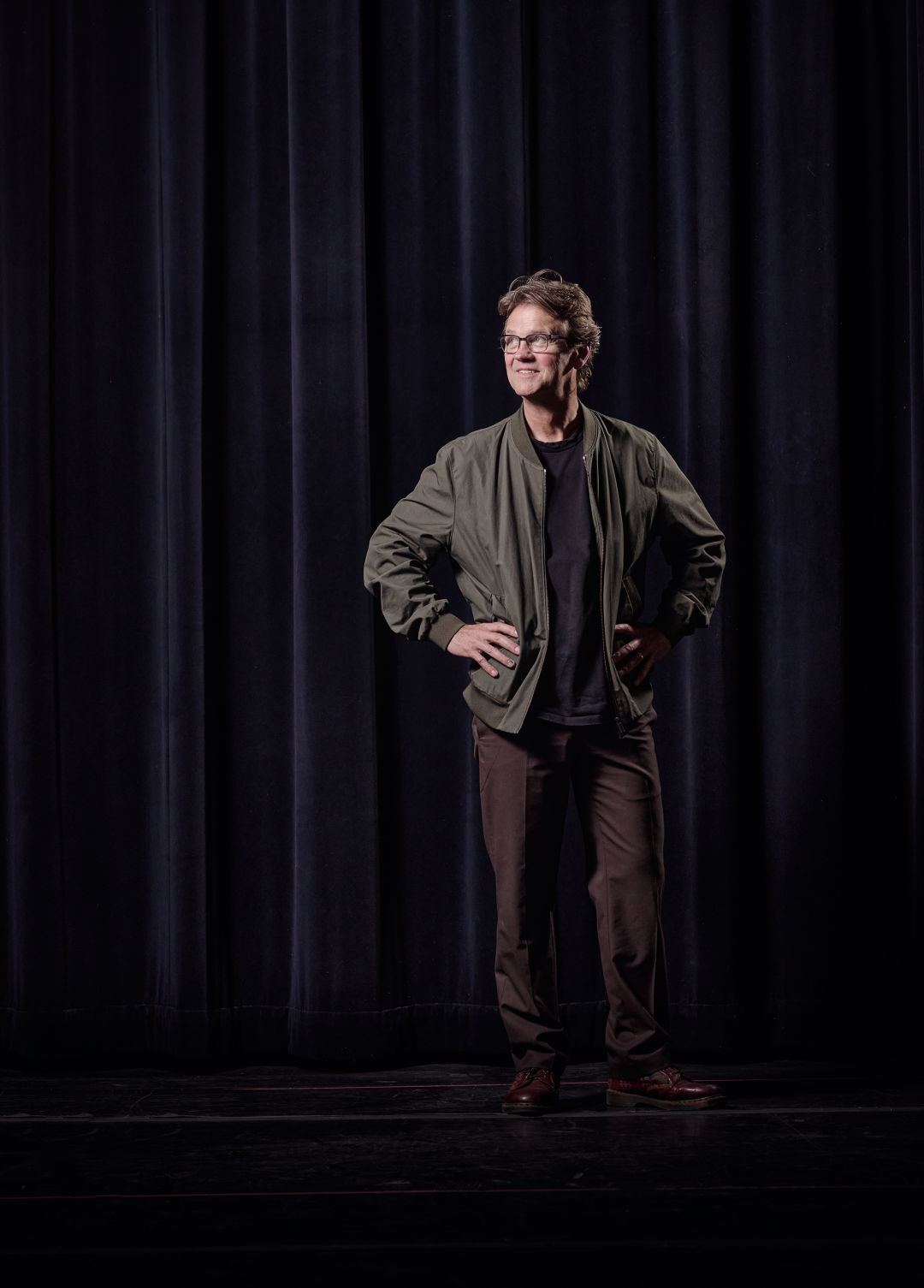
“There’s just one strata of society that buys a ticket and goes to see theater,” says Curry, pictured, “and I want a broader exposure.”
But when I first called Curry, last September, it was impossible to get him to talk about the creative process. I brought up theater; he answered by discussing Portland State University’s campus housing and the upcoming mayoral election. The next second it was a cultural corridor and how former Mayor Vera Katz knew her development work around the river was the start of something bigger. “It is the most important cultural venue in the state”—we were now talking about the Keller—“but not recognized in any way for being that.” The fountain and auditorium shouldn’t be an “island,” Curry said, but a cultural hub, an artistic spine of the city. “I immediately started thinking about it as a whole, concocted plan—a citywide plan,” he said. It was Portland’s shot at a catalytic spectacle, like Chicago’s “Bean” or Seattle’s Space Needle: something purposeful, but also worth talking about, worth visiting whether you have tickets for a show inside or not. The fountain, listed on the National Register of Historic Places, was the city’s buried treasure. To Curry, ever the showman, an appropriately modern set dressing was the key to uncovering it.
Going from designing masks and theatrical sets, however elaborate, to drafting building blueprints isn’t the most lateral move. But Curry had made that leap years ago. Primarily working with Wynn Resorts across the US and as far away as Macau and the United Arab Emirates, Curry expanded his theatrical work to include designing entire theaters inside resorts and theme parks, several on par with the Keller’s estimated $300 million budget. And while his company still supports 50 touring shows and employs 62 people, Curry spends much of his own time today creating such spaces. He even uses the term placemaking. The Keller project seemed to fit right in, save one notable distinction. Until that call in 2016, Curry’s visions were confined to Broadway stages, Disney and Universal theme parks, and the phantasmagorical world that is Las Vegas. The Keller would bring him public. “There’s just one strata of society that buys a ticket and goes to see theater,” Curry says, “and I want a broader exposure.”

A rendering of Curry’s renovation plans for the auditorium and plaza.
Two finalists emerged in the city’s design competition: Curry’s remodeling pitch, backed by the Halprin conservancy’s powerful board and a “shovel-ready” schematic from local architecture firm Hennebery Eddy; and a plan to build a new theater on PSU’s campus. A series of city hall hearings grew somewhat combative, shedding light on the ramifications the theater holds for Portland’s future. Eventually, the city asked the two parties to combine their plans. With each hinging on their specific locations, how exactly they were to be combined was never terribly clear.
Curry, meanwhile, had begun taking on more public projects. His approach to the Keller caused “a ricochet effect,” he says, showing how his skill set translated to civic planning. This past summer, he helped judge a placemaking competition at PSU. Though its location traditionally drove enrollment, being downtown had the opposite effect in the pandemic; the area became “a place nobody wanted to be,” says Sarah Schwarz, president of the PSU Foundation. He is also at work on a proposal, in collaboration with the Waterfront Blues Festival and a host of community figures, to remake Gov. Tom McCall Waterfront Park into something like New York’s Central Park or the Brooklyn Botanical Gardens. Broadly, the idea is to wrap the park with an iron fence, replacing the temporary fences large events currently require, and fit the river’s edge with a modular barge stage to save the trouble of erecting a new one for every show.
To Curry, this “offstage” work is inherently connected to the Keller project—it’s about bringing theater into the public. For example, his plan for the Keller reads like a play: It’s a love story in which Curry cast himself as Cupid. Standing on the dull auditorium’s roof, he shoots his arrow into the globally influential marvel of landscape architecture out front, the Keller Fountain, causing a billowing wall of curved glass to arch across SW Third Avenue. This mushrooming facade wraps the entire building in glass, cleverly expanding its square footage, but bows most dramatically toward the fountain. The result is a wave-like roof covering most of the plaza between the fountain and building. Addressing Huxtable’s notes 50 years on, the script brings the auditorium back into the foreground, literally.

With Curry’s design approach, the Keller Fountain will become inextricably tied to the theater, its windows leaning toward the fountain with an almost romantic longing.
“Rather than notionally, we wanted to physically attach the two,” says MAciej Woroniecki, a partner at London-based entertainment architecture firm StuFish, who worked with Curry on the design. Instead of keeping the auditorium closed off—as it’s been for the past century, out of sight and mind for most Portlanders—the drama could now spill onto the street, with films and light shows projected against the fountain’s falling water and performances on its natural stages.
“That was the trigger that got us to think about this not as the Keller Auditorium restoration, but as the twenty-first-century Keller that is a new destination for that part of town,” says Karen Whitman, executive director of the Halprin Landscape Conservancy. “There was a marriage there, except that nobody ever saw it as a marriage.”
Curry’s work on The Lion King was radical because, instead of hiding the performers, his puppets enthusiastically advertised them. Simba and Nala masks stand above the actors’ own visible faces. Zazu, the toucan, perches on a puppeteer’s bowler hat. Dancers wearing three puppet gazelles, on their head and right and left hands, bounce and hold their bodies in the animal’s signature stiff stot midair: four gazelles. Dynamic and transparently self-aware, the show has run for nearly 30 years and played for 60 million people. In a similar fashion, Curry’s Keller plan functions like an elegant, translucent scaffolding showing off a century of Portland history. The swooning portico, with all its romantic narrative, is also a seismic brace.

Ira Keller and Angela Danadjieva pose in front of the Forecourt Fountain in 1970.
Placemaking is supposed to raise “urban vitality,” a vague notion, though there are a few metrics. The public-private agency Portland Downtown Clean & Safe maintains a “vibrancy tracker” that reports foot traffic, vacancy rates, hotel occupancy, and public safety to monitor the area’s status. Urban design is one of many factors at play, but the Keller makes a compelling case study: Is there a level of design good enough to restore downtown as a cultural hub?
Many would argue there is, pointing to this very spot to prove it. In the late 1950s, urban development efforts targeted what was once a Jewish and Italian immigrant neighborhood as the South Auditorium Renewal area. After bulldozing 54 city blocks and displacing some 1,500 residents, Portland was well on its way to a slick new city center fit for the upper crust. That is, until, as former Portland Monthly editor Randy Gragg once wrote, “a landscape architect named Lawrence Halprin and his wife, dancer Anna Halprin, slipped something into the water.”
Lawrence Halprin was a star artist and flower child whose ability to keep the suits happy won him the reputation of a peoples’ city designer. He had recently developed the grounds for the Seattle World’s Fair, which debuted the Space Needle, when he was asked to quite literally remap a large swath of Portland. Tellingly, his biography is titled City Choreographer; he choreographed parks around a “score,” the intended melody people would make moving through them. His diminutive but symbolic Source Fountain, on SW Lincoln and what should be Second Avenue, led to the Lovejoy Fountain and through Pettygrove Park’s buxom berms before culminating at the Forecourt Fountain, later renamed for Ira Keller, who had led the urban renewal efforts as chair of the Portland Development Commission. Built between 1963 and 1970, Halprin’s sequence made public space visible in a new way and proved its effectiveness. Instead of the white-collar crowd strolling the parks, “hippies” reportedly descended en masse. Frustrating the well-heeled, Halprin’s designs worked too well, genuinely serving the public instead of only performatively. The sequence led, like its symbolic current, to the river, when the city tore up Harbor Drive in favor of a park. By the mid-’80s, Portland doubled down on people-friendly public spaces, choosing to create Pioneer Courthouse Square instead of a parking garage.
At the end of November, I met Curry on an overcast morning outside the Keller. “It’s kind of a ratty landscape,” he said. “Halprin never imagined these trees getting so big.” He said he brought a group of designers here early on, waving his arms to represent the love affair between the fountain and the building. He grew animated describing his vision, ecstatic about “how much variety, texture, and drama you can put in that little 65-foot area—it’s as big as the Metropolitan Opera stage!”
The month before, the city announced it would back both the PSU and Keller projects in succession, with the university’s ground-up construction preceding the Keller remodel. The PSU theater is projected to open in 2029, after which the Keller would close for two years of construction, reopening in 2031. “That’s not a decision,” Curry said, a little incredulous. With an almost entirely new city government in office this year, it’s hard to make out exactly how the decision will hold up. (The hearings did not explicitly pledge any public funding, though both plans count on it.) However, Sarah Schwarz, of the PSU Foundation, says fundraising and designs of the PSU project are already underway. Karen Whitman, of the Halprin conservancy, says they are continuing to push the agenda, while also recognizing “there’s a new sheriff in town” in Mayor Keith Wilson. If the Keller has to wait until 2029, Whitman says the conservancy plans to renovate the fountain per Curry’s vision sooner, insisting that “Third Avenue is going to be a destination.”
Standing in front of the fountain, Curry outlined his ideas for the sequence: marking the parks with wayfinding lights and flags, scheduling performances
on the fountain’s stages. He brought up his plans to invite filmmakers to screen movies against its falling water. And then—“Here comes a ukulele player,” he broke off. “That’s cool. With a fur collar and a cigarette.” He seemed to want the ukulele player to play, to prove the plaza still “worked.”
Conversation sauntered back to the frustrating start-stop of the restoration and the drowning politics of it all. As we talked, the fountain seemed to disappear. Passersby didn’t glance toward it or the auditorium. Curry continued to light up, gesticulating enthusiastically, excited as ever about the marionette he wants to hang from the building, an homage to Anna Halprin.
The ukulele player loped around the park behind him, as if looking for something he couldn’t find. I said it was serendipitous, this lone performer not performing, pacing through the fountain’s platforms. But Curry was rapping again. The texture and drama. That little 65-foot area as big as the Metropolitan Opera stage. And this performer, standing in that very spot, was looking for a stage because he couldn’t see he was already standing on one.
Share this content:


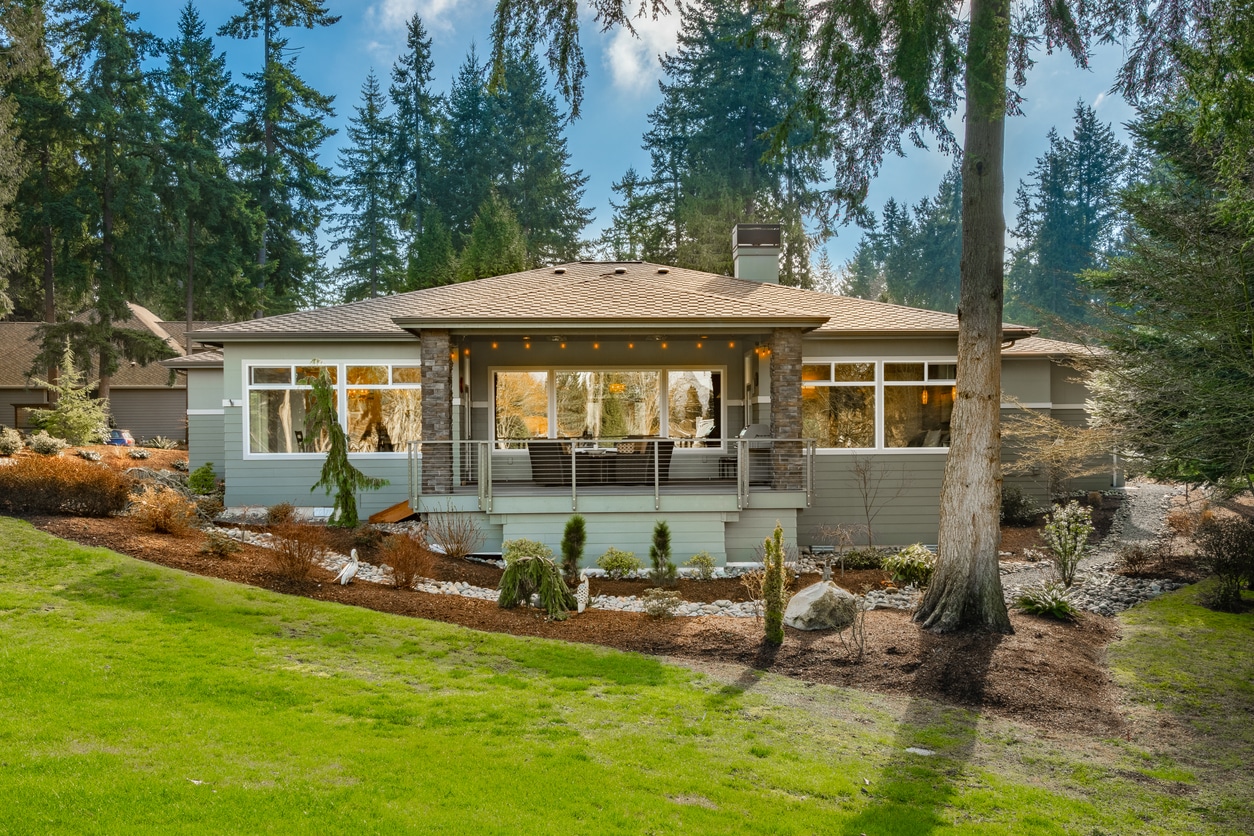
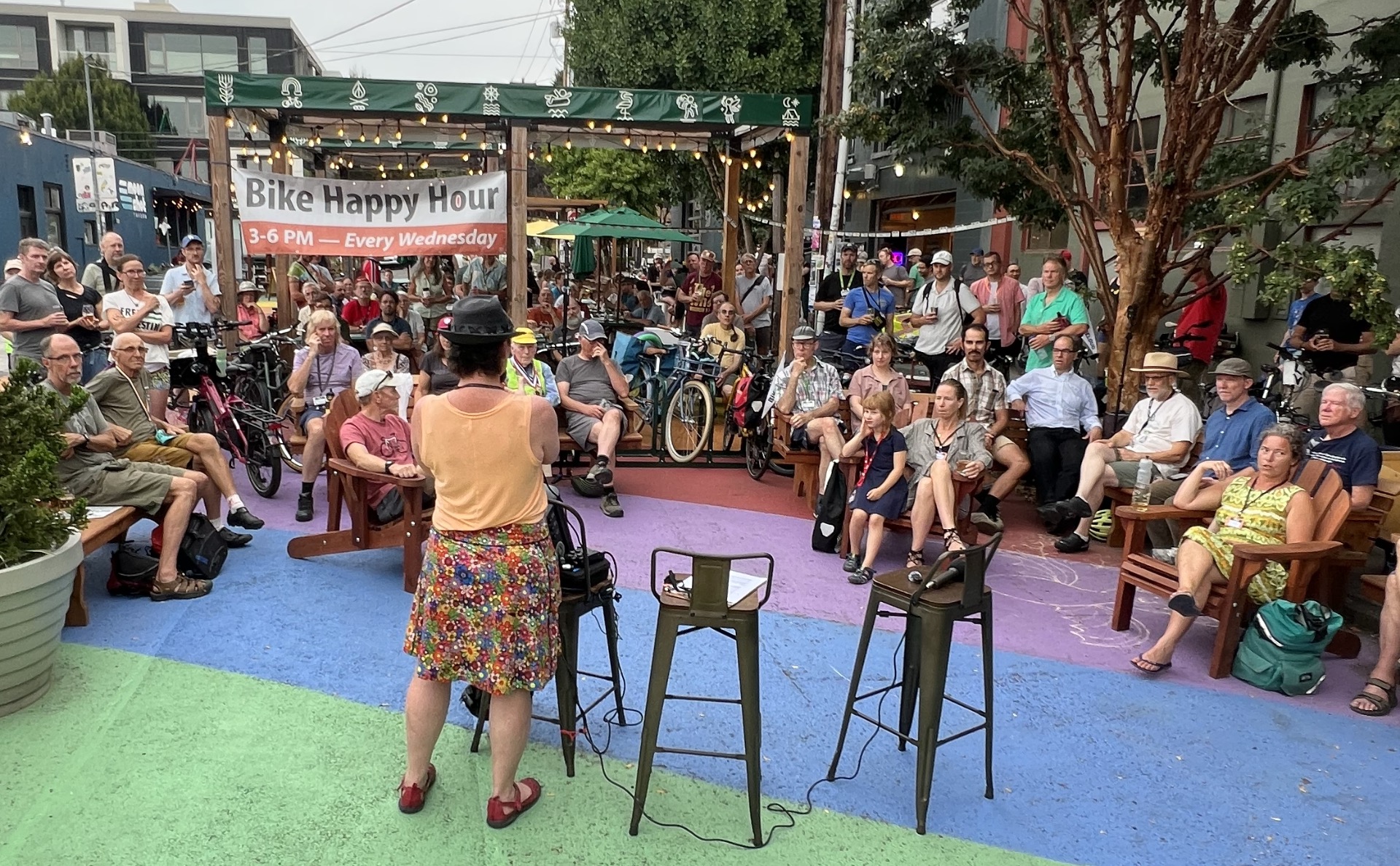


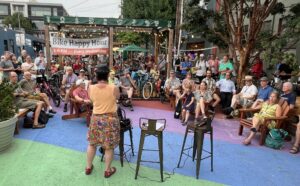


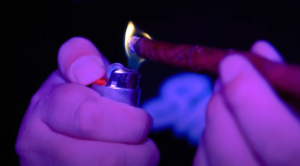
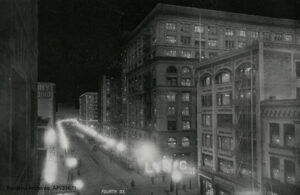
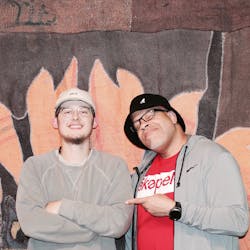
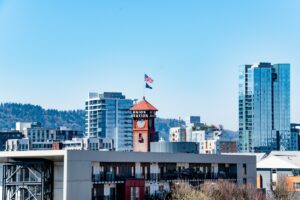
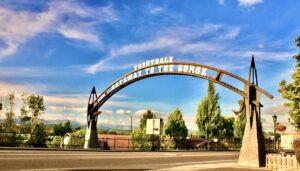
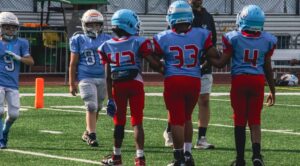
Post Comment